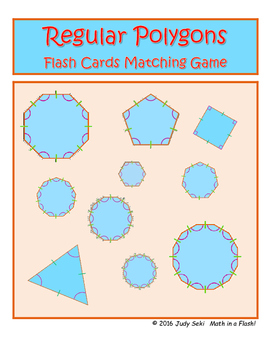Regular Polygons - Angles and Perimeter Flash Cards Matching Game
JUDY SEKI
22 Followers
Grade Levels
7th - 10th, Homeschool
Subjects
Resource Type
Standards
CCSS8.G.A.5
Formats Included
- PDF
Pages
14 pages
JUDY SEKI
22 Followers
Description
Regular polygons are all around us, and their beauty is that they provide so many opportunities for increasing mathematical understanding! With this amazing flash card game, students explore these areas by working together to match 20 sets of 5 cards each. Included are 10 different polygons, and student must match the picture, name, perimeter, and sums of both interior and exterior angles. Each type of polygon has 2 sets, so that students can clearly see that angles remain the same while the perimeter changes. Students quickly learn that the sum of the exterior angles is always the same, and they come to recognize that, as the number of sides increases, the shape approaches that of a circle. This activity takes students away from worksheets as it promotes mental math, and increased comfort with terminology. It is ideal for English language learners, and for practice in mastering the Common Core Standards. Whether you use these cards as a center or whole class project, your students will be engaged as they learn in this kinesthetic activity. - from Judy Seki for "Math in a Flash!"
Total Pages
14 pages
Answer Key
Included
Teaching Duration
N/A
Last updated Sep 1st, 2016
Report this resource to TPT
Reported resources will be reviewed by our team. Report this resource to let us know if this resource violates TPT’s content guidelines.
Standards
to see state-specific standards (only available in the US).
CCSS8.G.A.5
Use informal arguments to establish facts about the angle sum and exterior angle of triangles, about the angles created when parallel lines are cut by a transversal, and the angle-angle criterion for similarity of triangles. For example, arrange three copies of the same triangle so that the sum of the three angles appears to form a line, and give an argument in terms of transversals why this is so.





